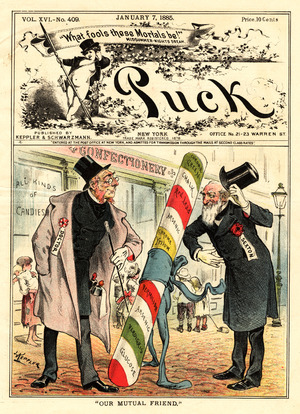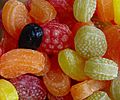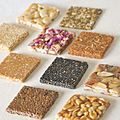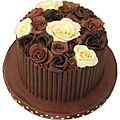Candy facts for kids
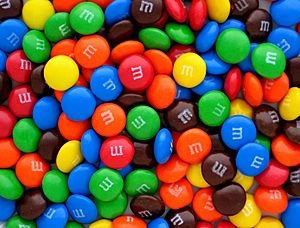
Candy is a sweet kind of food that is usually made from sugar and water, with flavours and other ingredients added. The word candy comes from the Persian word for "cane sugar", and probably also from Sanskrit khanda, which means "piece (of sugar)".
Candy is found in almost any store because they are made in many companies. Candy can also be made at home. Many people like candy and think it tastes good. Other people do not like it. Candy contains lots of sugar, so it is not very healthy, but can be eaten sometimes. It is the most common snacking food, and there are hundreds of flavours, shapes, and sizes.
Candy, also called sweets or lollies, is a confection that features sugar as a principal ingredient. The category, called sugar confectionery, encompasses any sweet confection, including chocolate, chewing gum, and sugar candy. Vegetables, fruit, or nuts which have been glazed and coated with sugar are said to be candied.
Physically, candy is characterized by the use of a significant amount of sugar or sugar substitutes. Unlike a cake or loaf of bread that would be shared among many people, candies are usually made in smaller pieces. However, the definition of candy also depends upon how people treat the food. Unlike sweet pastries served for a dessert course at the end of a meal, candies are normally eaten casually, often with the fingers, as a snack between meals. Each culture has its own ideas of what constitutes candy rather than dessert. The same food may be a candy in one culture and a dessert in another.
Contents
History
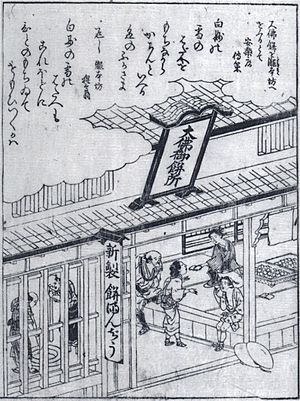
The word candy entered the English language from the Old French çucre candi ("sugar candy"). The French term probably has earlier roots in the Arabic qandi, Persian qand and Sanskrit khanda, all words for sugar.
Sugarcane is indigenous to tropical South and Southeast Asia. Pieces of sugar were produced by boiling sugarcane juice in ancient India and consumed as khanda. Between the 6th and 4th centuries BCE, the Persians, followed by the Greeks, discovered the people in India and their "reeds that produce honey without bees". They adopted and then spread sugar and sugarcane agriculture.
Before sugar was readily available, candy was based on honey. Honey was used in Ancient China, the Middle East, Egypt, Greece and the Roman Empire to coat fruits and flowers to preserve them or to create forms of candy. Candy is still served in this form today, though now it is more typically seen as a type of garnish.
Before the Industrial Revolution, candy was often considered a form of medicine, either used to calm the digestive system or cool a sore throat. In the Middle Ages candy appeared on the tables of only the most wealthy at first. At that time, it began as a combination of spices and sugar used as an aid to digestion. Banquet hosts typically served these types of 'candies' at banquets for their guests. One of these candies, sometimes called chamber spice, was made with cloves, ginger, aniseed, juniper berries, almonds and pine kernels dipped in melted sugar.
The Middle English word candy began to be used in the late 13th century.
The first candy came to America during the early 18th century from Britain and France. Only a few of the early colonists were proficient in sugar work and sugary treats were generally only enjoyed by the very wealthy. Even the simplest form of candy – rock candy, made from crystallized sugar – was considered a luxury.
Industrial Revolution
The candy business underwent a drastic change in the 1830s when technological advances and the availability of sugar opened up the market. The new market was not only for the enjoyment of the rich but also for the pleasure of the working class. There was also an increasing market for children. While some fine confectioners remained, the candy store became a favorite of the child of the American working class. Penny candies epitomized this transformation of candy. Penny candy became the first material good that children spent their own money on. For this reason, candy store-owners relied almost entirely on the business of children to keep them running. Even penny candies were directly descended from medicated lozenges that held bitter medicine in a hard sugar coating.
In 1847, the invention of the candy press (also known under the surprising name of a toy machine) made it possible to produce multiple shapes and sizes of candy at once. In 1851, confectioners began to use a revolving steam pan to assist in boiling sugar. This transformation meant that the candy maker was no longer required to continuously stir the boiling sugar. The heat from the surface of the pan was also much more evenly distributed and made it less likely the sugar would burn. These innovations made it possible for only one or two people to successfully run a candy business.
As the path from producer to market became increasingly complicated, many foods were affected by adulteration and the addition of additives which ranged from relatively harmless ingredients, such as cheap cornstarch and corn syrup, to poisonous ones. Some manufacturers produced bright colors in candy by the addition of hazardous substances for which there was no legal regulation: green (chromium(III) oxide and copper acetate), red (lead(II,IV) oxide and mercury sulfide), yellow (lead chromate) and white (chalk, arsenic trioxide).
In an 1885 cover cartoon for Puck, Joseph Keppler satirized the dangers of additives in candy by depicting the "mutual friendship" between striped candy, doctors, and gravediggers. By 1906, research into the dangers of additives, exposés of the food industry, and public pressure led to the passage of the Pure Food and Drug Act, the first federal United States law to regulate food and drugs, including candy.
Production
Candy is made by dissolving sugar in water or milk to form a syrup, which is boiled until it reaches the desired concentration or starts to caramelize. Candy comes in a wide variety of textures, from soft and chewy to hard and brittle. The texture of candy depends on the ingredients and the temperatures that the candy is processed at.
Most candies are made commercially. The industry relies significantly on trade secret protection, because candy recipes cannot be copyrighted or patented effectively, but are very difficult to duplicate exactly. Seemingly minor differences in the machinery, temperature, or timing of the candy-making process can cause noticeable differences in the final product.
Nutrition
Even in a culture that eats sweets frequently, candy is not a significant source of nutrition or food energy for most people.
Health effects
Candy generally contains sugar, which is a key environmental factor in the formation of dental caries (cavities). Several types of bacteria commonly found in the mouth consume sugar, particularly Streptococcus mutans. When these bacteria metabolize the sugar found in most candies, juice, or other sugary foods, they produce acids in the mouth that demineralize the tooth enamel and can lead to dental caries. Heavy or frequent consumption of high-sugar foods, especially lollipops, sugary cough drops, and other sugar-based candies that stay in the mouth for a long time, increases the risk of tooth decay. Candies that also contain enamel-dissolving acids, such as acid drops, increase the risk. Cleaning the teeth and mouth shortly after eating any type of sugary food, and allowing several hours to pass between eating such foods, reduces the risk and improves oral health.
Health benefits
Candies that primarily consist of peppermint and mint, such as candy canes, have digestive benefits. Peppermint oil can help soothe an upset stomach by creating defense against irritable bowel syndrome and is effective in killing germs.
Mint-flavored gum increases short-term memory, heart rate, and the amount of oxygen in the brain. The correlation between heart rate and oxygen in the brain triggers short-term memory. Chewing gum can also provide a burst of insulin in the anticipation for food.
When eaten in moderation, dark chocolate can have health benefits. The cocoa in chocolate can help reduce the risk of heart disease. Vitamins and minerals such as calcium, magnesium, and sodium can be found in chocolate, as well as antioxidants.
Images for kids
-
Karl Fazer (1866–1932) founded the successful Fazer company in the 1890s, which at the time specialized exclusively in the candy and confectionery industry.
-
Licorice is a candy flavored with the extract of the roots of the licorice plant. It is popular in Finland.
-
Individually wrapped butterscotch candies.
-
Halloween candy being sold at a supermarket in Virginia
-
Konpeitō is a traditional Japanese sugar candy. When finished, it is almost 100% solid sugar.
-
Fruit-shaped hard candy is a common type of sugar candy, containing sugar, color, flavor, and a tiny bit of water.
-
Chikki are homemade nut brittles popular in India. Between the nuts or seeds is hard sugar candy.
-
German Haribo gummy bears were the first gummi candy ever made. They are soft and chewy.
-
Fudge is a type of sugar candy that is made by mixing and heating sugar, butter and milk.
-
Unsweetened baking chocolate contains no sugar.
-
Bittersweet or dark chocolate contains some sugar.
-
Milk chocolate contains milk and lower levels of cocoa solids.
-
Because white chocolate contains no cocoa solids, it is classified as sugar confectionery instead of chocolate.
-
Compound chocolate is used in place of pure chocolate to reduce costs.
-
These flowers were made from modeling chocolate.
See also
 In Spanish: Caramelo (golosina) para niños
In Spanish: Caramelo (golosina) para niños


